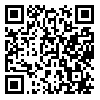شمارۀ جدید فصلنامه (پاییز1404) منتشر شد
دوره 15، شماره 4 - ( 10-1403 )
جلد 15 شماره 4 صفحات 314-269 |
برگشت به فهرست نسخه ها
Download citation:
BibTeX | RIS | EndNote | Medlars | ProCite | Reference Manager | RefWorks
Send citation to:



BibTeX | RIS | EndNote | Medlars | ProCite | Reference Manager | RefWorks
Send citation to:
moghimi A, parsamehr M, ruhani A. (2024). The Professional Identity of Teachers at the Intersection of Economic, Political and Social Structures: A Grounded Theory in Yazd. Social Problems of Iran. 15(4), 269-314. doi:10.61186/jspi.15.4.8
URL: http://jspi.khu.ac.ir/article-1-3740-fa.html
URL: http://jspi.khu.ac.ir/article-1-3740-fa.html
مقیمی اعظم، پارسامهر مهربان، روحانی علی.(1403). هویت حرفهای معلمان در تقاطع ساختارهای اقتصادی، سیاسی و اجتماعی؛ یک مطالعۀ زمینهای در یزد مسائل اجتماعی ایران 15 (4) :314-269 10.61186/jspi.15.4.8
اعظم مقیمی1 

 ، مهربان پارسامهر*2
، مهربان پارسامهر*2 

 ، علی روحانی3
، علی روحانی3 




 ، مهربان پارسامهر*2
، مهربان پارسامهر*2 

 ، علی روحانی3
، علی روحانی3 


1- دانشجوی دورهٔ دکتری جامعهشناسی، گروه جامعهشناسی، دانشکدهٔ علوم اجتماعی، دانشگاه یزد، یزد، ایران
2- دانشیار گروه جامعهشناسی، دانشکدهٔ علوم انسانی و اجتماعی، دانشگاه مازندران، بابلسر، ایران ،Parsamehr@yazd.ac.ir
3- دانشیار گروه جامعهشناسی، دانشکدهٔ علوم اجتماعی، دانشگاه یزد، یزد، ایران
2- دانشیار گروه جامعهشناسی، دانشکدهٔ علوم انسانی و اجتماعی، دانشگاه مازندران، بابلسر، ایران ،
3- دانشیار گروه جامعهشناسی، دانشکدهٔ علوم اجتماعی، دانشگاه یزد، یزد، ایران
چکیده: (925 مشاهده)
پژوهش حاضر با هدف مطالعۀ چگونگی برساخت هویت حرفهای در بین معلمان شهر یزد انجام شده است. هویت حرفهای چهارچوب تفسیری و خودپندارۀ حرفهای معلمان دربارۀ خودشان است که از برهمکنش با شرایط و زمینههای متنوع به وجود میآید. در اجرای این پژوهش از نظریۀ زمینهای اشتراوس و کربین بهره گرفته شد. مشارکتکنندگان ۲۰ نفر از معلمان شهر یزد در سنین، جنسیت و مقاطع مختلف تحصیلی مختلف بودند که با آنها مصاحبههای عمیق نیمهساختاریافته صورت گرفت. اطلاعات بهدستآمده ابتدا کدگذاری و سپس مقولهبندی و تحلیل شد. «هویت پارهپاره» مقولۀ هسته پژوهش بود که از برساخت مقولههای (فرودستشدگی اقتصادی، هویت ابزاری و هویت اجتماعی تضعیفشده) به دست آمد. عوامل علّی تأثیرگذار بر این نوع از هویت شامل (تنگناهای معیشتی، رویکرد تبعیضی و نامتوازن حاکمیت و...)، عوامل زمینهای شامل (تحول ارزشی/ هنجاری معلمان، زوال منزلت اجتماعی معلمی و...) و عوامل مداخلهگر شامل (فرودستسازی اقتصادی نهاد آموزش، دیدهنشدن انتظارات مادی با شعارگرایی معنوی، فزایندگی بحرانهای اقتصاد بیمار و...) بود. مشارکتکنندگان در پاسخ به وضعیت هویتی خود از استراتژیهای مقاومت خاموش، اعتراض و... استفاده کردند و کاهش سرمایۀ اجتماعی، بیگانگی حرفهای، مشارکت تقلیلیافته و... بهعنوان پیامدهای حاصله شناسایی شد.
واژههای کلیدی: هویت حرفهای، هویت پارهپاره، فرودستشدگی اقتصادی، هویت ابزاری، هویت اجتماعی تضعیفشده
نوع مقاله: پژوهشی اصیل |
موضوع مقاله:
مسائل اجتماعی
دریافت: 1403/7/29 | پذیرش: 1403/9/19 | انتشار: 1403/11/12
دریافت: 1403/7/29 | پذیرش: 1403/9/19 | انتشار: 1403/11/12
فهرست منابع
1. پالمر، پارکر.جی (1400)، شهامت تدریس سفری به دنیای درون معلم (ترجمه نوگل روحانی). تهران: هوش ناب.
2. پیریایی، حسین و شهبازی، شهرام (1393). نقش و جایگاه معلم در تحول بنیادین آموزشوپرورش. ماهنامه رشد فناوری آموزش، 29(7)، 17-4.
3. حجازی، اسد (1397). تعیین ابعاد و مؤلفههای هویت حرفهای معلمان ابتدایی. فصلنامه راهبردهای نوین تربیتمعلمان، 4(6)، 56-36.
4. حیدری، نقدعلی، عطاران، ژیلا و حاجیحسیننژاد، محمد (1392). تجربههای دوران تحصیل و شکلگیری هویت حرفهای معلم: پژوهشی خود مردمنگارانه. پژوهشهای انسانشناسی ایران،3(1)، 28-7.
5. رضایی، منیژه (1391). بررسی مسائل حرفهای ادراکشده از سوی معلمان با سوابق خدمتی متفاوت در نظام آموزشی ایران. فصلنامۀ نوآوریهای آموزشی، 44(11)، 139-119.
6. رومانی، سعید، حاجیحسیننژاد، غلامرضا، حسینیخواه، علی و فاضلی، نعمتالله (1396). شناسایی و واکاوی فرهنگ معلمان ابتدایی استان لرستان: رویکرد مردمنگاری. فصلنامه تعلیم و تربیت، 137، 192-167.
7. رئوف، علی (1379). جنبش جهانی برای بهسازی تربیتمعلم. تهران: وزارت آموزشوپرورش، پژوهشکده تعلیم و تربیت.
8. صافی، احمد (1382). تأمین و تربیتمعلم در ایران: گذشته، حال و آینده. فصلنامه تعلیم و تربیت، 72 و 73، 49-11.
9. صافی، احمد (1387). سیر تحول تربیتمعلم در آموزشوپرورش معاصر ایران: گذشته، حال و آینده. فصلنامه تعلیم و تربیت، 4(96)، 42-15.
10. صولتی، مهران (1399). مسئلهای به نام معلم ایرانی. فصلنامه تخصصی فلسفه آموزش، 1(1)، 47-39.
11. فاضلی، نعمتالله (1390). مردمنگاری آموزش (چند مطالعه مردمنگارانه در زمینه آموزشوپرورش امروز ایران). تهران: علم.
12. فاضلی، نعمتالله (1392). تاریخ فرهنگی ایران مدرن: گفتارهایی در زمینه تحولات گفتمانی ایران امروز از منظر مطالعات فرهنگی. تهران: پژوهشگاه علوم انسانی و مطالعات فرهنگی.
13. فاضلی، نعمتالله (1397). مدرسه بهمثابه میدان معنا، برگرفته از کتاب مرگ مدرسه (به کوشش خسرو باقری و مرتضی نظری). 142 -107.
14. فاضلی، نعمتالله (1398). معلمی، تراژدی فرهنگ مدرن ایران. مجله خبری تحلیلی رسانه فرهنگ، انجمن ایرانی مطالعات فرهنگی و ارتباطات، 13(44)، 23-21.
15. قربانی، حسین، میرشاهجعفری، سیدابراهیم، نصراصفهانی، احمدرضا و نیستانی، محمدرضا (1398). چرایی تا چیستی معلمی: زندگی کاوی مبتنی بر خودشرححالنویسی مشارکتی در بستر تعلیم و تربیت. دوفصلنامه تربیت اسلامی، 14(29)، 178-153.
16. کهندل، مرضیه، کرمی، مرتضی، آهنچیان، محمدرضا و مهرمحمدی، محمود (1397). بازنمایی مناقشات ناظر بر دو گفتمان توسعه حرفهای و هویت حرفهای معلم از منظر مناسبات قدرت. پژوهشنامه مبانی تعلیم و تربیت، 8(2)، 122-103.
17. محمدی، داود (1395). جدی بودن بحران هویت حرفهای در سیمای شغل معلمی در ایران. مجله الکترونیک صدای معلم http://www.sedayemoallem.ir
18. محمودیبورنگ، محمد و نبئی، حمزه (1398). عوامل مؤثر بر هویت حرفهای معلم: مروری نظاممند. فصلنامه توسعه حرفهای معلم، 4(1)، 94-77.
19. مسرور، رضا (1394). بازنگری علل مؤثر بر نقش معلم در ارتقای کیفیت امور فرهنگی تربیتی دانشآموزان آیندهسازان جامعه. سومین همایش ملی مدرسه فردا.
20. مقیمی، اعظم، پارسامهر، مهربان و روحانی، علی (1402). از انگیزهها تا ترسها: کاوشی از هویت حرفهای معلمان. فصلنامه پژوهشهای راهبردی مسائل اجتماعی ایران،12(40)، 66-37.
21. مهدیان، سمیه، حکیمزاده، رضوان، صفاییموحد، سعید و صالحی، کیوان (1396). بازنمایی ادراک و تجربه زیسته معلمان از منزلت اجتماعیشان، مطالعهای به روش پدیدارشناسی. فصلنامه خانواده و پژوهش، 38، 37-19.
22. میرعربرضی، رضا، فردانش، هاشم و طلایی، ابراهیم (1391). فرهنگ معلمی: عاملی مهم در تحقق یا عدم تحقق اصلاحات برنامه درسی مدرسهای. فصلنامه مطالعات برنامه درسی ایران، 7(26)، 104-83.
23. نجاتی، لیلا، عباسیان، حسین، زینآبادی، حسن و آراسته، حمیدرضا (1398). واکاوی پدیده بدبینی سازمانی معلمان: یک پژوهش روش کیفی. فصلنامه مدیریت مدرسه، 8(4)، 153-135.
24. نظری، مرتضی، باقری، خسرو، رنانی، محسن، عشایری، حسن، فاضلی، نعمتالله، فراستخواه، مقصود، قانعیراد، محمدامین و محمدی، جعفر (1397). مرگ مدرسه: گفتارهای انتقادی در آموزشوپرورش ایران. تهران: مشق شب، 105-79.
25. ولیزاده، لیلا و قربانی، احمد (1394)، هویت حرفهای پرستاران و عوامل مرتبط با شکلگیری آن: یک مقاله مروری. نشریه پژوهش پرستاری، 10(4)، 88-97.
26. Alvesson, M., & Willmott, H. (2002). Identity regulation as organizational control: Producing the appropriate individual. Journal of Management Studies. 39, 619-644.
27. Anspal, T., Eisenschmidt, E., & Lofstrom, E. (2012). Finding myself as a teacher: Exploring the shaping of teacher identities through student teachers’ narrative. Teachers and Teaching: Theory and Practice, 18(2), 197-216.
28. Antonek, J. L., McCormick, D. E., & Donato, R. (1997). The student teacher portfolio as autobiography: Developing a professional identity. Modern Language Journal. 81(1),15–27.
29. Ashford, S.J, & Taylor, M.S. (1990). Adaptation to work transitions: An integrative approach. In G.R. Ferris and K.M. Rowland (eds), Research in Personnel and Human Resources Management. 8, 1- 39.
30. Ashforth, B.E., & Johnson, S.A. (2001). Which hat to wear? The relative salience of multiple identities in organizational contexts. In M.A. Hogg and D.J. Terry (eds), Social Identity Processes in Organizational Contexts. Philadelphia, PA: Psychology Press. 31-18.
31. Aydin, I., Guner, T., & Erdmli, O, (2015). Teachers views regardin the social status of the teaching profession, Anthropologist. 22(2), 146-156.
32. Beauchamp, C., & Thomas, L. (2009). Understanding teacher identity: An overview of issues in the literature and implications for teacher education. Cambridge Journal of Education. 39(2), 175-189.
33. Beijaard, D. (1995). Teachers’ prior experiences and actual perceptions of professional identity. Teachers and Teaching: Theory and Practice. 1(2), 281–294.
34. Beijaard, D., Verloop, N., & Vermunt, J. D. (2000). Teachers’ perceptions of professional identity: An exploratory study from a personal knowledge perspective. Teaching and Teacher Education, 16, 749–764.
35. Bergami, M., & Bagozzi, R.P. (2000). Self-categorization, affective commitment and group self-esteem as distinct aspects of social identity in the organization. British Journal of Social Psychology, 6, 17-55.
36. Caplow, T. (1966). Sequential steps in professionalization. In H.L. Vollmer and D.L Mills (eds), Professionalism. Englewood Cliffs, NJ: Prentice-Hall, 19- 21.
37. Clandinin, D. J., & Connelly, F. M. (1996). Teachers’ professional knowledge landscapes: Teacher stories-stories of teachers-school stories-stories of schools. Educational Researcher, 25(3), 24–30.
38. Coldron, J., & Smith, R. (1999). Active location in teachers’ construction of their professional identities. Journal of Curriculum Studies, 31(6), 711–726.
39. Cooley, Ch. H. (1902). Human Nature and the Social Order. New York: Scribners.
40. Day, C. (2004). A Passion for teaching. London: Routledgefalmer.
41. Day, Ch., Kingtona, A., Stobartb, G., & Sammons,P. (2005). The personal and professional selves of teachers: stable and unstable identities. British Educational Research Journal, 32(4), 601–616.
42. Dillabough, J. A. (1999). Gender politics and conceptions of the modern teacher: Women, identity and professionalism. British Journal of Sociology of Education, 20(3), 373–394.
43. Dutton, J.E., Dukerich, J.M., & Harquail, C. (1994). Organizational images and member identification. Administrative Science Quarterly, 39, 239-263.
44. Gardner, P. (1995). Teacher training and changing professional identity in early twentieth century England. Journal of Education for Teaching, 21(2), 191-218.
45. Goddard,R. 2003. Beginning teacher perceptions of their work, well-being and intention to leave. Asia Pacific Journal of Teacher Education and Development, 6(2). 99-110.
46. Goodson, I. F., and Cole, A. L. (1994). Exploring the teacher's professional knowledge: Constructing identity and community. Teacher Education Quarterly, 21(1), 85–105
47. Haslam, S.A. (2001). Psychology in Organizations: The Social Identity Approach. London: Sage.
48. Hogg, M.A., & Terry, D.J. (2000). Social identity and self-categorization processes in organizational contexts. Academy of Management Review, 25, 121-140.
49. Ibarra, H. (1999). Provisional selves: Experimenting with image and identity inprofessional adaptation. Administrative Science Quarterly,44(4), 764-791.
50. Mael, F., & Ashforth, B.E. (1992). Alumni and their alma mater: A partial test of the reformulated model of organizational identification. Journal of Organizational Behavior, 13, 103-123.
51. Mawhinney, H., & Xu, F. (1997). Restructuring the identity of foreign-trained teachers in Ontario schools. TESOL Quar-terly, 31(3), 632–639.
52. McCrae, N., Jones,A. S., & laker, C. (2014).Merely a stepping stone?professional identity and career prospects following postgraduate mental health nurse training. Journal of psychiatric and mental health nursing, 21(9), 767-273
53. Morrow, PC., & Goetz, J.F. (1988). Professionalism as a form of work commitment. Journal of Vocational Behavior, 32, 92-111.
54. Nicholson, N. (1984). A theory of work role transitions. Administrative Science Quarterly, 29(2), 172-191.
55. Olsen, B. (2008). How reasons for entry into the profession illuminate teacher identity development. Teacher Education Quarterly, 35(3).
56. Palmer, P. J. (1997). The courage to teach: Exploring the inner landscape of a teachers life. San Francisco, CA: Jossey-Bass Publishers.
57. Pratt, M.G. (1998). To be or not to be: Central questions in organizational identification. In D.A. Whetton and PC. Godfrey (eds), Identity in Organizations: Building Theory Through Conversations. Sage Publications, 171-207.
58. Pratt, M.G. (2012). Rethinking identity construction processes in organizations: Three questions to consider. Oxford University Press, 21-49.
59. Pratt, M.G., & Foreman, P. (2000). Classifying managerial responses to multiple identities. Academy of Management Review, 25, 18-42.
60. Roberts, L.M., Dutton, J.E., Spreitzer, G.M., Heaphy, E.D. & Quinn, R.E. (2005). Composing the reflected best self portrait: Building pathways for becoming extraordinary in work organizations. Academy of Management Review, 30, 712-736.
61. Samuel, M., & Stephens, D. (2000). Critical dialogues with self: developing teacher identities and roles-a case study of South Africa. International Journal of Educational Research, 33(5), 475–491.
62. Schein, E.H. (1978). Career Dynamics: Matching Individual and Organizational Needs. Reading, MA: Addison-Wesley.
63. Serpe, R.T., & Stryker, S. (1987). The construction of self and reconstruction of social relationships. Greenwich, CT: JAI, 41-66.
64. Skorikov, V. & Vondracek, R. W. (1998).Vocational identity development: its relationship to other, identity domains and to overall identity development. Journal of Career Assessment, 6(1).
65. Slay, H., & Smith, D.A. (2011). Professional identity construction: Using narrative to understand the negotiation of professional and stigmatized cultural identities. Human Relations, 64, 85-107.
66. Solari, A & Ortega, E.M. (2020). Teachers’ professional identity construction: A sociocultural approach to its definition and research. Journal of Constructivist Psychology, 35, 626 - 655.
67. Stryker, S. & Burke, P.J. (2000). The past, present, and future of an identity theory. Social Psychology Quarterly, 63, 284-297.
68. Stryker, S. (1987). The Interplay of affect and identity: exploring the relationships of social structure, social interaction, self, and emotion. Chicago, IL: American Sociological Association.
69. Sugrue, C. (1997). Student teachers’ lay theories and teaching identities: Their implications for professional development. European Journal of Teacher Education, 20(3), 213–225.
70. Tajfel, H., & Turner, J.C. (1985). The social identity theory of intergroup behavior. Chicago, IL: Nelson-Hall, 7-24.
71. Tsang, Kwok Kuen. (2015). Sociological research on teachers’ emotions: four approaches and the shared themes. Journal of Sociological Research, 6(2).
72. Van Maanen, J., & Barley, S.R. (1984). Occupational communities: Culture and control in organizations. Research in Organizational Behavior, 6, 287-365.
73. Volkmann, M. J., & Anderson, M. A. (1998). Creating professional identity: Dilemmas and metaphors of a first-year chemistry teacher. Science Education, 82(3), 293–310.
74. Yilmaz, F., & Ilhan, M. (2017).Who are teachers? A Study of identity hierarchy. Cogent education, 1(4).
ارسال پیام به نویسنده مسئول
| بازنشر اطلاعات | |
 |
این مقاله تحت شرایط Creative Commons Attribution-NonCommercial 4.0 International License قابل بازنشر است. |





